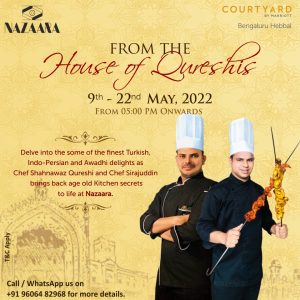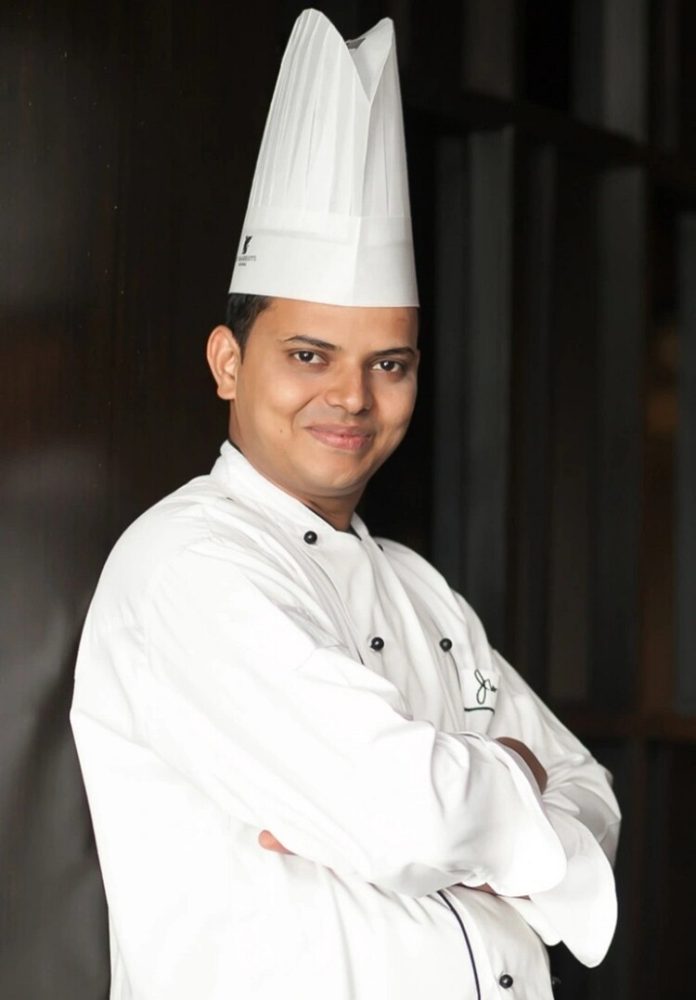Courtyard by Marriott Bengaluru Hebbal hosted a royal Nawabi food fair from the 9th of May to the 22nd of May. The festival offers delightful recipes from the treasure trove of House of Qureshi’s Chef Shahnawaz Qureshi, a fourth-generation descendant of the famous Qureshi family, and Courtyard Hebbal’s Indian master Chef Sirajuddin at Nazaara. The two collaborated to make this food festival one to remember and put forward a fantastic lineup of dishes and desserts that surely whet up the guest’s appetite.
So I spoke to Chef Qureshi about the synthesis of Awadhi cuisine and his journey in preparing various gastronomical delights over the years. He’s also had the opportunity to work at the iconic ‘Tunde Ke Kebab’ in Lucknow, where he learned the art of slow cooking, marination, and the use of spices with various meats. But Qureshi’s culinary curiosity goes way back to when he was a teenager. “I was 15 when I prepared kacche gosht ki biryani for the first time.” replied the chef. He was never told about any marination processes, yet he indulged in the technique and created the special. He saw the use of the same marination methods only when he started working in a restaurant.
Chef Shahnawaz began his career at a young age, learning the trade from his father and older brother in their kitchen. Their recipes are etched in his memory, yet he’s improvised a little on his own, and all the offerings on his menu today are his creations. “Everyone knows about the famous Nalli Nihari from Lucknow, but Koh-e-Awadh is a dish that I have concocted in my style,” comments Qureshi.
He has also established a masala venture – HNS Lucknow Spice. The chef explains, “My go-to ingredient is dalchini (cinnamon) and kalimirch (peppercorn), but I always maintain the proportion of spices as per the weather. Currently, I’m in Bangalore, so I will use the spices accordingly. When I’m in the North, I mostly use ingredients like khus ki jadh (dried vetiver roots), and paan ki jadh (dried betel roots) as the climate is hotter”. He also uses pippali at times for sourness in the kebabs.
One legendary dish by Qureshi served during this 14-day food festival includes Murgh Baradari – his signature chicken curry made with cubeba cheeni masala. He describes the dish as unique and explains its overnight marination process and the ingredients he uses for the mixture. “I mix pyaaz, chironji, dahi, haldi, mirchi, dhaniya, and some secret spices that I’ve brought from Lucknow. I don’t reveal anything about them to anyone” says the chef.

Zaitooni Kofta Anari is another vegetarian main where the key ingredient is Super Negin Saffron sourced from Fatehpur Sikri, a region in Awadh, and Naan-E-Zaatar, Qureshi’s classic bread blended with earthy and subtle citrus undertones and a hint of nuttiness with thyme, toasted sesame seeds, sumac, and a dash of oregano. However, the chef recommends tandoori aloo, koh-e-awadh, and khamiri roti to go with it.
As we dig more into his recipes reserve, Chef Qureshi offers the recipe for a flavoursome chicken dish that is marinated twice. First with lemon, vinegar, and curd, then with brown caramelised onion, cashew, and gulkand (rose petal jam). “The chicken softens just as Pasanda without any additives,” claims Qureshi.
Fascinating me with his cooking stories, he mentions the pandemic period when he facilitated cooking classes for his clients from Mumbai, Macau, and other cities. “It was God’s mercy that I did not have to sit idle during the lockdown,” says Qureshi. He admits to being scared and wary of the future due to the spread of coronavirus. He continues, “I like to cook and wish to share my art and knowledge with as many people as possible, so here I am in Bengaluru, cooking for its people.” The 14-day-long celebration of Awadhi cuisine at Courtyard by Marriott Bengaluru Hebbal ends today.
About the Chef: Chef Shahnawaz started early on in life, imbibing skills from his father and elder brother in their kitchen. These recipes, which he learned from them, are family jewels, they were used by their ancestors whilst serving the Nawabs. He then had the opportunity of working at the renowned kebab joint Tunde Ke Kebab in Lucknow, where he mastered the art of slow cooking, marination and using spices with different meats.
In the court of Avadh- fashion, poetry, calligraphy, architecture, music and dance scaled never experienced heights. And in its cuisine, there was a coming together of all that it meant to experience the most delicate and the most heightened visual, artistic, spiritual, and gastronomical delights.
Biriyani came to Avadh from Delhi and Hyderabad with the royal brides who brought their retinue of cooks with them. But the parboiled rice with meat pieces was at once declared by the nawabs to be too coarse for their delicate palettes. Thus, efforts were made to improve it. This resulted in the yakhni pulao in which the rice was cooked in rich meat stock and no bone pieces or whole spices obstructed its eating.
About the Author: Geetika Mishra is a writer/storyteller, and a small business owner in the milk processing sector in her hometown Madhubani. You can connect with Geetika here.





















